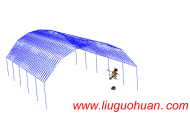基岩地震谱与地震动位移输入的土–结构相互作用(SSI)计算模型改进作者: 柳国环,陆新征 |
||||||
下载次数:
次 更多论文下载...
PDF下载:
2011 年5 月
摘要:对基岩地震动输入的适用性和SSI 计算模型的合理性进行研究。首先,借鉴已有基岩地震谱表达式,采用数值方法修正高频段过滤函数,得到适用于我国目标场地的基岩地震谱;然后,分析当前位移输入的SSI 计算模型,指出所存在的因单元尺寸划分逐步精细而导致的不收敛问题,推广无质量刚性元(massless rigid element,MRE)法解决这一问题,并给出MRE、结构系统和黏弹性人工边界三者间连接示意图;最后,基于上述工作和随机振动理论生成基岩地震动位移输入谱,对一算例进行分析,结果表明采用MRE 法解决SSI 计算模型的可行性。研究工作可为土–结构共同作用相关问题的研究提供参考。 关键词:地震工程;基岩地震动;无质量刚性元(MRE)法;土–结构相互作用 中图分类号:P 315.9 文献标识码:A 文章编号:1000–6915(2011)05–0884–09 Abstract:The applicability of spectra of bedrock earthquake motion and rationality of calculation model considering soil-structure interaction(SSI) for structural seismic response analysis are studied. Firstly,in order to obtain the spectra of bedrock earthquake motion in China,not only the expressions of the current spectra of earthquake bedrock motion are compared and the preferred one is selected;but also the high-cut filter function is modified to fit the recorded earthquake motion of target fields in China. Then,the current SSI calculation model for structural seismic response analysis is expounded essentially;and the unnegligible problem inherent in the model is pointed out. To solve the problem,the massless rigid element(MRE) method proposed by the authors to solve the problem inherent in the earthquake ground displacement input model is extended and applied to solve the corresponding problem in the current bedrock displacement input model considering SSI effect. At last,based on the works above,the program for generating bedrock displacement spectrum is coded and a soil-layers model is analyzed. The analysis results can further indicate that the MRE method is quite applicable to the calculation Key words:earthquake engineering;bedrock earthquake motion; massless rigid element(MRE)method;soilstructure interaction(SSI) 引言 地震作用下土–结构相互作用(soil-structure interaction,SSI)问题的研究涉及到如下两方面内容:(1) 基岩地震动输入;(2) 结构地震响应的 SSI计算模型。前者的适用性与后者的合理性是保障分析结果可靠的必要条件。然而,我国目前的相关研究面临2 个现实问题:(1) 在我国,公开且有效的基岩地震动记录(包括震级、震源深度、震中距、基岩密度和波速等参数)相对甚少;(2) 由于位移输入模型不仅适用于一致输入而且也适用于多点输入,不仅适用于线性分析而且也适用于非线性分析,但是基于地震动位移输入的SSI 计算模型存在基底单元内力随着单元划分逐步划分精细而不收敛的问题。本文将围绕这两方面开展工作。结构地震响应分析,包括频域分析和时域分析。岩松宏等[1]采用随机振动理论,研究了频域内深埋隧道的可靠度问题。在基岩地震动输入下,考虑SSI的频域计算需要输入基岩地震动的傅立叶谱(简称基岩地震谱)或相应的功率谱;时域计算需要基岩地震动,而基岩地震动可通过基岩地震谱生成。因此,得到适用于我国目标场地的基岩地震谱具有现实意义。基岩地震谱一般通过震源谱、衰减函数和高频滤波函数共同来描述。王国新[2]考虑到美国强震记录相对丰富全面,对我国地震工程研究具有很强的借鉴意义,对比研究了Brune,Atkinson 双拐点和Masuda 震源谱的特点,结合3 种典型震源谱的优缺点并通过改进和拟合,给出了具有广泛适用性的Masuda 震源谱参数值a 和b,使其既满足大、小震级要求,又同时符合震源谱曲线的中低频段“下沉”特点。H. Hao 和B. A. Gaull[3]基于西澳地区的基岩地震动记录,结合Atkinson 双拐点震源谱给出了适用于西澳地区的基岩地震谱。由此容易想到,尽管美国部分地区(例如美国西部)的地质构造与我国相类似,但基于上述3 种震源谱(Brune,Atkinson双拐点和Masuda 震源谱)、衰减函数和高频段过滤函数得到的基岩地震谱与我国岩石场地的地震谱是否吻合?是否适用? 有必要作进一步研究。基于这一出发点,本文依据我国的具体基岩地震记录(仅限于震级、震源深度和震中距参数齐全,且水平和竖向基岩地震动有效合理的记录),在形式上借鉴并优选了基岩地震谱表达形式,在数值上调整了高频过滤函数,得到了可适用于我国目标场地的基岩地震谱,考察了其适用性,为考虑SSI 作用的结构地震响应计算所需的基岩地震动输入提供参考。在得到有效基岩地震动的前提下,求解地震响应SSI 计算模型的合理性则直接关系到计算结果的可靠性。为此,本文论述了当前SSI 计算模型,指出了其存在的问题,并说明该问题与地震地面运动输入下结构地震响应位移输入模型中问题的本质相同,进而采用笔者提出的MRE 法,以解决SSI 计算模型中存在的这一问题。最后,针对一土层算例,采用MRE 法进行基岩输入下的频域分析,说明MRE 解决SSI 计算的可行性。 结论 地震作用下 SSI 问题的研究涉及到2 个问题:基岩地震动输入和求解地震响应的SSI 计算模型。本文围绕地震动输入的有效性与SSI 计算模型的合理性得到了以下结论: (1) 借鉴基岩地震谱表达式,修正高频段过滤函数,得到可用于我国目标场地的基岩地震谱; (2) 论述当前SSI 计算模型实质,明晰其与地震地面运动位移输入下模型本质的一致性,进而明确指出其存在的因单元尺寸加密而导致的不收敛问题,从而将笔者提出的MRE 方法推广以解决这一问题。 (3) 本文的工作可为土–结构共同作用相关问题研究提供参考。随着我国基岩地震动的公开、有效且参数齐全资料增多,可进一步完善本文提出的模型。 参考文献(References): [1] 岩松宏. 地下结构随机地震响应分析及其动力可靠度研究[J]. 岩石力学与工程学报,2004,23(2):355.(YAN Songbo. Dynamic analysis of longitudinal seismic reliability of underground structures[J]. Chinese Journal of Rock Mechanics and Engineering,2004,23(2):355.(in Chinese)) [2] 王国新. 强震地震动衰减研究[博士学位论文][D]. 哈尔滨:中国地震局工程力学研究所,2001.(WANG Guoxin. A study on strong ground motion attenuation[Ph. D. Thesis][D]. Harbin:Institute of Engineering Mechanics of China Seismological Bureau,2001.(in Chinese)) [3] HAO H,GAULL B A. Prediction of seismic ground motion in Perth Western Australia for engineering application[C]// Proceedings of the 13th World Conference on Earthquake Engineering. Vancouver,Canada:[s.n.], 2004:1892. [4] HANKS T,KANAMORI H. A moment magnitude scale[J]. Journal of Geophysical Research,1979,84(B5):2 348–2 350. [5] HANKS T,MCGUIRE R. The character of high-frequency strong ground motion[J]. Bulletin of Seismological Society of America,1981,71(6):2 071–2 095. [6] BRUNE J N. Tectonic stress and the spectra of seismic shear waves from earthquakes[J]. Journal of Geophysical Research,1970,75(26):4 997–5 009. [7] BRUNE J N. Correction[J],Journal of Geophysical Research,1971,76(20):5002. [8] ATKINSON G M. Earthquake source spectra in eastern North America[J]. Bulletin of Seismological Society of America,1993,83(6):1 778–1 798. [9] ATKINSON G M,BOORE D M. Ground-motion relations for eastern North America[J]. Bulletin of Seismological Society of America,1995,85(1):17–30. [10] MASUDA T. Scaling relations for source parameters of microearthquakes in the northeastern part of Japan[Ph. D. Thesis][D]. Senda city,Japan:Tohoku University,1982. [11] 黄少鹏. 我国大陆地区大地热流与地壳厚度的变化[J]. 地球物理学报,1992,35(4):441–450.(HUANG Shaopeng. Variations of heat flow and crustal thickness in the continental area of China[J]. Chinese Journal of Geophysics,1992,35(4):441–450.(in Chinese)) [12] WILSON E L. Static and dynamic analysis of structures:a physical approach with emphasis on earthquake engineering[M]. Berkeley,California:Computers and Structures,Inc.,2004:319 [13] 田玉基,杨庆山. 地震地面运动作用下结构反应的分析模型[J]. 工程力学,2005,22(6):170–174.(TIAN Yuji,YANG Qingshan.Analysis models and methods for structural seismic responses[J].Engineering Mechanics,2005,22(6):170–174.(in Chinese)) [14] 柳国环,李宏男,林海. 结构地震响应计算模型的比较与分析[J].工程力学,2009,26(2):10–15.(LIU Guohuan,LI Hongnan,LIN Hai. Model comparison and analysis for structural seismic responses[J]. Engineering Mechanics,2009,26(2):10–15.(in Chinese)) [15] 柳国环,李宏男,国巍. 求解结构地震响应位移输入模型存在的问题及其AMCE 实效对策[J]. 计算力学学报,2009,26(6):862–869.(LIU Guohuan , LI Hongnan ,GUO Wei. Existing problem of displacement input model for calculating structural responses under earthquake ground motion and its an actual effective solution method called AMCE[J]. Chinese Journal of Computational Mechanics,2009,26(6):862–869.(in Chinese)) [16] 柳国环,李宏男,国巍,等. 求解结构地震响应位移输入模型中存在问题的一种新解决方法[J]. 工程力学,2010,27(9):55–62.(LIU Guohuan,LI Hongnan,GUO Wei,et al. A new method for solving existing problem of current displacement input model for calculating structural seismic responses[J]. Engineering Mechanics,2010,27(9):55–62.(in Chinese)) [17] 刘晶波,王振宇,杜修力,等. 波动问题中的三维时域黏弹性人工边界[J]. 工程力学,2005,22(6):46–51.(LIU Jingbo,WANG Zhenyu,DU Xiuli,et al. Three-dimensional viscous-spring artificial boundaries in time domain for wave motion problems[J]. Engineering Mechanics,2005,22(6):46–51.(in Chinese)) [18] 刘晶波,谷 音,杜义欣. 一致黏弹性人工边界及黏弹性边界单元[J]. 岩土工程学报,2006,28(9):1 070–1 075.(LIU Jingbo,GU Yin,DU Yixin. Consistent viscous-spring artificial boundary and viscous-spring boundary element[J]. Chinese Journal of Geotechnical Engineering,2006,28(9):1 070–1 075.(in Chinese)) |
||||||
| welcome to www.liuguohuan.net |
| 天津大学 建筑工程学院 ; 天津大学 前沿技术研究院; 国家重点实验室-水利工程仿真与安全 |







